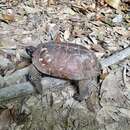Lifespan, longevity, and ageing
provided by AnAge articles
Maximum longevity: 22.9 years (captivity)
- license
- cc-by-3.0
- copyright
- Joao Pedro de Magalhaes
- editor
- de Magalhaes, J. P.
Biology
provided by Arkive
The spiny turtle has not thrived in captivity and relatively little is known of its breeding habits (8). Mating behaviour is apparently stimulated by rains, with males becoming excited when sprayed with water in captivity, chasing females in an attempt to mount. Nesting behaviour is unknown in the wild, but generally one or two eggs are laid per clutch (clutches containing three eggs have been recorded) in captivity, usually at night or in the early morning (7). Up to three clutches have been produced a year (7), and to enable the passage of these relatively large eggs, a hinge develops in the female's plastron to allow greater flexibility during egg-laying (5). There have only ever been a handful of successful captive breeding efforts of the spiny turtle, and those that have been successful have had incubation periods of 106 days (2), 110 days (9) and 145 days (10).
The spiny turtle is apparently herbivorous in the wild, preferring fruits and vegetables, but will accept some animal foods in captivity (5) (7).
Conservation
provided by Arkive
Like many other species, the spiny turtle would benefit from captive breeding programmes or 'turtle farms' to supply the food and pet market, and thereby mitigate the demand to remove large numbers from the wild (4). Unfortunately, this species is notoriously difficult to breed in captivity and only a handful of institutions have ever successfully bred the species, including Zoo Atlanta and Knoxville Zoo in the US., and Durell Wildlife in Jersey, Europe (9) (11). Nevertheless, these few successes provide fresh hope that a captive breeding programme might one day be able to haul the species back from the brink of extinction (12). It is also hoped that these successful reproductive attempts will help provide more information about the biology and ecology of this beautiful yet complex species, information that can prove invaluable for conservation action in the wild (11) (12).
Description
provided by Arkive
The origin of its common and specific name is immediately apparent from the sharp, pointed, spiky-edged carapace, and spiny keel, of this unique turtle, also known as the 'cog-wheel turtle'. There are also smaller spines on the pleural scutes, creating the effect of a walking pin cushion (4). It is thought that this spiny 'armour' acts as a deterrent to predators, such as snakes (5). However, this unmistakable, strongly-serrated carapace edge and spiny keel become worn down and are lost with age, so that larger individuals are much smoother than juveniles (6) (7). The carapace is brown with a pale streak down the central keel, and the head and limbs are greyish-brown, usually with a yellow to red spot behind the eye and similar-coloured speckling on the legs (4) (5). This cryptic colouration helps camouflage the turtle amongst the leaf litter of its forest floor habitat (6). The plastron is buff coloured with an intricate pattern of dark radiating lines on each scute (4) (7).
Habitat
provided by Arkive
This semi-aquatic species is found in shallow, wooded mountain streams, but spends considerably time on land foraging or burrowing amongst the leaf litter of the forest floor (4). At least in captivity, juveniles appear to be more terrestrial than adults (7).
Range
provided by Arkive
The spiny turtle ranges throughout Southeast Asia, from Thailand and possibly southern Myanmar southward through Malaysia to Sumatra, Borneo and Natuna, numerous small Indonesian Islands and the Philippines (1) (7).
Status
provided by Arkive
Classified as Endangered (EN) on the IUCN Red List 2006 (1) and listed on Appendix II of CITES (3).
Threats
provided by Arkive
Like most Asian turtle species, the spiny turtle is in grave danger of extinction due to over-collection from the wild for the Asian food market and international pet trade, as well as being threatened by the destruction of its habitat (11). Wild populations are thought to be plummeting, particularly in Indonesia, where they are considered Critically Endangered and known trade volumes have recently declined by about 50 %. Elsewhere, the species is restricted to small and isolated populations over much of its range (1). When they reach the West and enter the pet market, imported Asian turtles are often parasite ridden and mortality is relatively high (4) (8). Many have also had to endure poor and incredibly stressful conditions in food markets, and are dehydrated and malnourished from their long journeys from the Asian food markets to the Western pet trade (8). Unfortunately, the extreme difficulty in breeding this species in captivity means that all specimens found in pet stores today are still caught from the wild and freshly imported from Asia.

